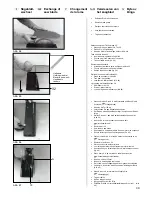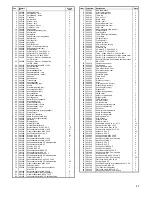
32
The circular saw bench is automatically turned off in the event of a
power failure. Press the green button to switch on again.
Switching off
⇒
Press the bottom red button.
The circular saw bench is fitted with a
braking motor
. The saw blade
must stand still within 10 seconds
after it was switched off
. The brake
is defective if this time is exceeded. The saw must then be repaired by
the manufacturer or a workshop appointed by the manufacturer.
Never operate the saw with
a defective brake
!
Motor protection
The motor is fitted with a
protective switch
which automatically
switches off the motor when it is overloaded. The motor can only be
switched on again after it has
cooled down
.
Maintenance and Care
Disconnect the
mains plug
.
Observe the following to maintain the
operability
of the circular saw
bench:
•
Clean and oil all moving parts
regularly
.
•
Always
keep the motor's cooling ribs clean to ensure adequate
cooling.
•
Ensure that the
saw blade
is always
free of rust and resin
.
•
Resin residues
must be removed from the
table board
.
•
The
saw blade
(wearing part) becomes blunt
after prolonged or
frequent use
.
⇒
the blade must be
resharpened or replaced
.
Guarantee
We grant a guarantee of one year, commencing with the day of delivery
from the dealer's store, for material and manufacturing faults.
Warranty claims, even during the warranty period, will not be accepted
for damages due to incorrect handling or inadequate packaging during
return of the devices or to a non-observance of the operating instruc-
tions.
Faulty parts must be sent to our works, postage or freight free. We
reserve the right to decide upon free spare part delivery.
Guarantee work will be completed by us or an authorised servicing
agency. Guarantee damage can only be remedied by another firm with
our explicit approval.
Guarantee is also granted if original spare parts are used.
Subject to changes in the interest of technical progress.
Possible faults and their elimination
Fault Possible
causes
Elimination
Saw does not start after it has
been switch on.
•
Power failure
•
Defective extension cable.
•
Motor protection switch has been tripped.
•
Defector motor or switch.
•
Jammed saw blade.
•
Change fuses.
•
Check cable; defective cables must not be used
again.
•
Switch on again after the motor has cooled down.
•
Motor or switch must be checked and repaired by
an authorised electrician, or replaced with an origi-
nal spare.
•
Remove table insert, and unscrew the chip box lid
and eliminate the cause.
Stiff height adjustment.
•
M6 nut (Fig. 3) too firmly tightened.
•
Dirty thread spindle.
•
Release slightly.
•
Clean and oil.
Stiff tilt adjustment.
•
Guiding parts do not slide in the drivinglink (Fig. 10).
•
Oil the guiding parts.
Motor generates insufficient power
and becomes too hot.
•
Three-phase motor is running on the second phase.
•
Extension cable too long or cable cross-section too
small.
•
Blunt saw blade.
•
the fuses and the supply lines must be checked by
an electrician.
•
See "Setting into Operation".
•
the saw blade must be resharpened or replace.
Insufficient sawing capacity.
Traces of burns on the saw blade.
•
Blunt saw blade.
•
the saw blade must be resharpened or replace.
Mise en service
•
Poser
la scie circulaire sur table
à un emplacement réunissant les
conditions suivantes :
non glissant
sans vibrations
plan
sans danger de chute
avec un éclairage suffisant
•
Avant chaque emploi
vérifiez :
si les
lignes de branchement
présentent des défectuosités
(fissures, coupures ou analogue).
N’employez pas de lignes défectueuses.
si
le capot de protection
est en parfait état
si
la
position du coin à refendre
(voir également fig. 40)
si
la lame
est en bon état
si
la pièce de poussée
est sous la main.
•
N’employez pas de
lames fissurées
ou déformées
•
N’employez pas de
lames en acier HSS
•
Placez-vous latéralement par rapport
à la zone dangereuse
(lame)
lorsque vous sciez.
•
Abaissez le
protège-lame
lors du travail
sur la pièce
en cas d’interruptions
ou en quittant la scie sur le plateau de
table.
Sens de rotation de la lame de scie
Veillez à ce que le sens de rotation de la lame
de scie corresponde au sens de rotation men-
tionné sur
le
capot de protection
(31). Vous
pouvez
modifier le sens de rotation
sur les
scies à moteur à courant triphasé, en agissant
avec un tournevis dans la fente prévue à cet
effet dans l’embase du connecteur et en réglant
le sens de rotation désiré en appuyant légèrement et en tournant vers
la gauche ou vers la droite.
Branchement au secteur
Comparez la tension marquée sur la plaque moteur de l’appareil (sur le
côté de la table), par ex. 230 V, à la tension de secteur et branchez la
scie à la prise correctement mise à terre.
•
Moteur à courant alternatif :
Employer une prise à contacts de sécurité, tension de secteur 230V
avec disjoncteur à courant de défaut et fusible 16A.
•
Moteur à courant triphasé :
Employer une prise CEE, 3 pôles +N+PE, tension de secteur 380
resp. 400 V avec disjoncteur à courant de défaut et fusible 16A.
Employez des fils ou rallonges selon DIN 57 282 (H 07 RN-F) avec une
section de câble d’au moins :
1,5 mm² pour une longueur allant
jusqu’à
25 m
2,5 mm² pour une longueur
de plus de
25 m
Содержание BTA 90
Страница 40: ...40 ...













































